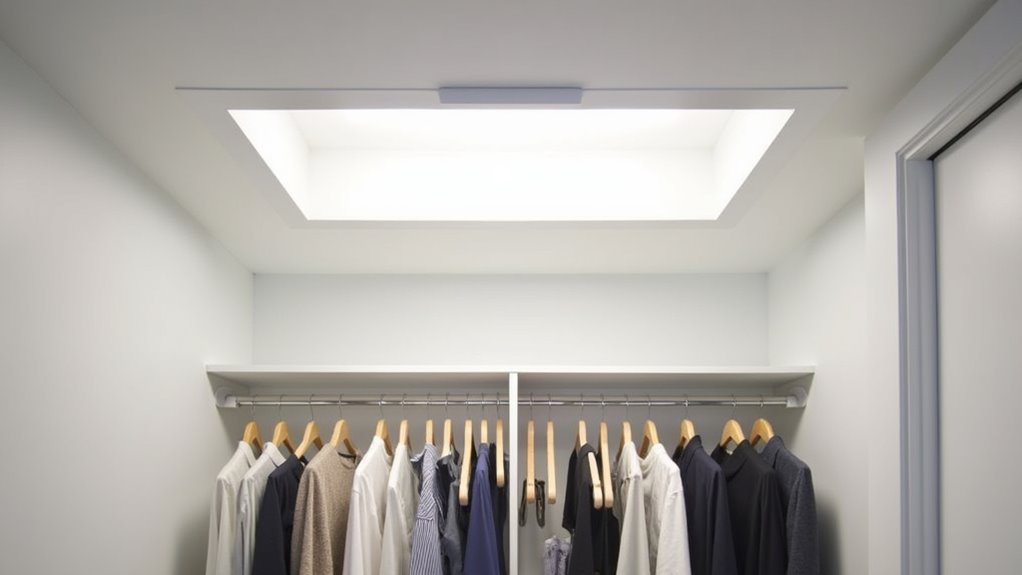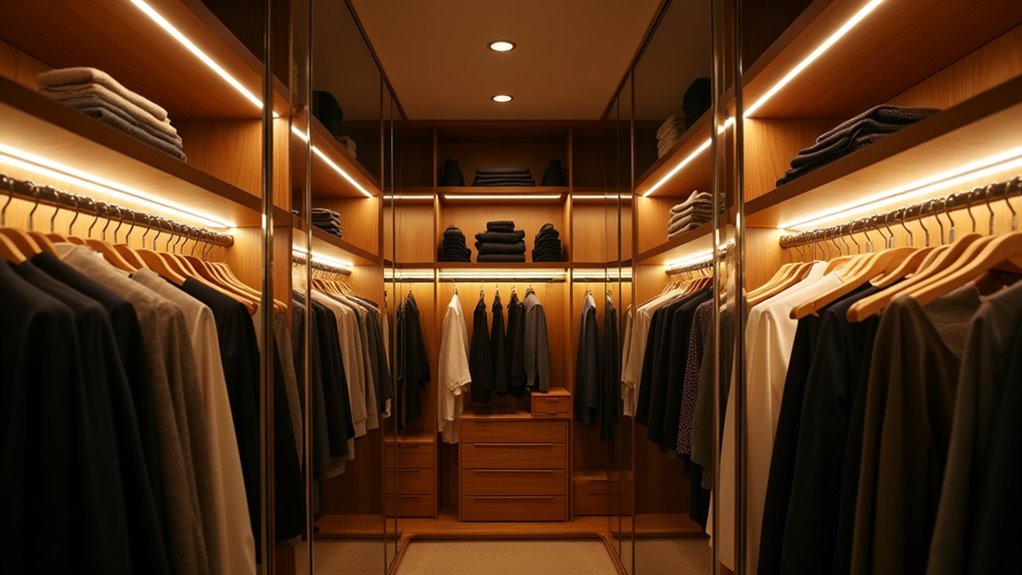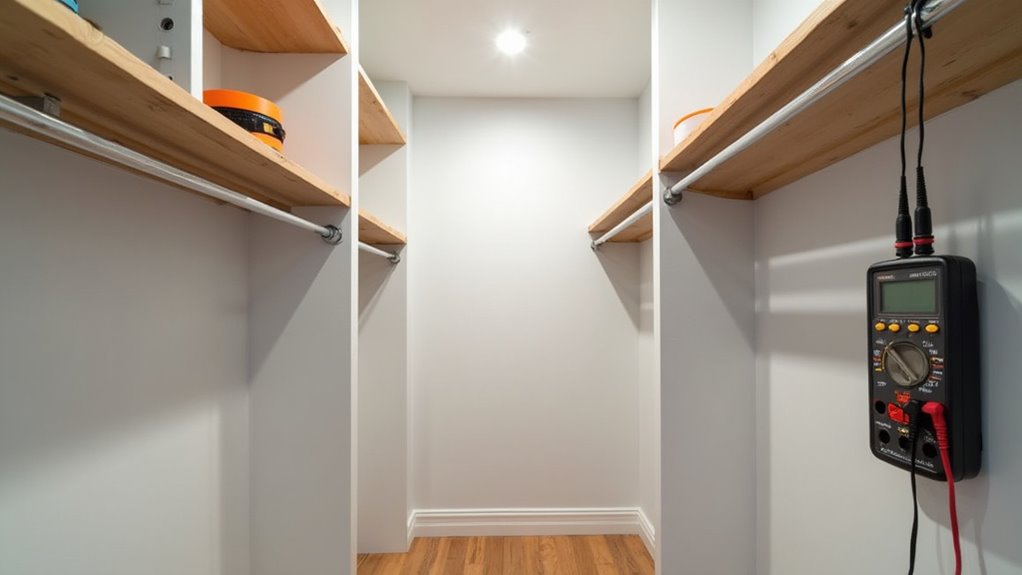Store your custom jewelry effectively by maintaining room temperature conditions in velvet-lined, compartmentalized containers away from moisture and sunlight. You’ll prevent tarnish and oxidation using anti-tarnish bags, silica gel packets, and proper spacing between pieces. Implement modular storage systems with adjustable dividers, dedicated hooks for chains, and protective barriers for delicate materials. Master these foundational techniques to protect your collection’s value, and discover advanced preservation methods to safeguard your finest pieces.
Choose the Right Storage Environment
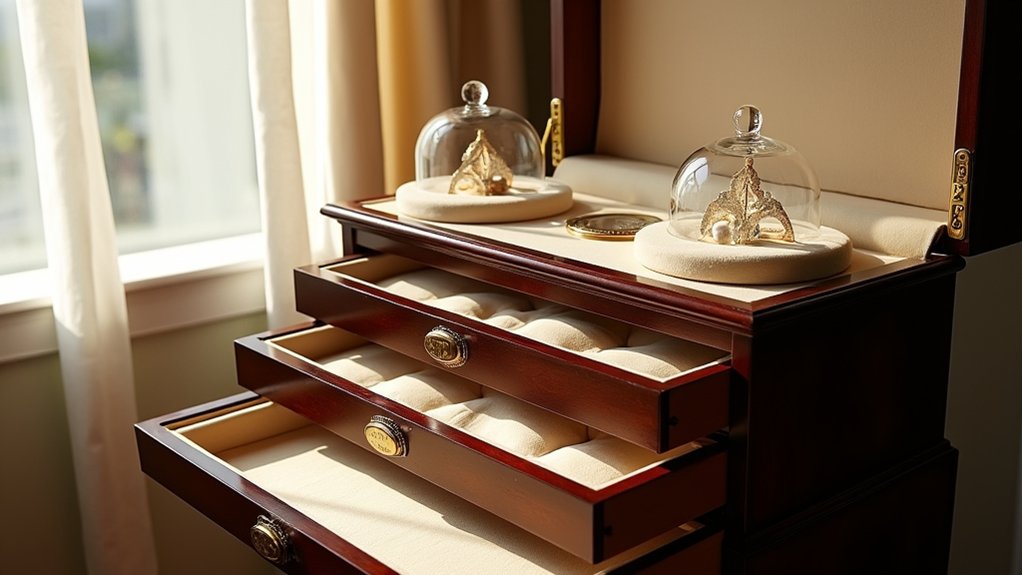
While protecting your custom jewelry requires attention to multiple factors, creating the right storage environment serves as the foundation for preserving your pieces’ integrity. Maintain ideal jewelry climate by storing pieces at room temperature, away from extreme temperature fluctuations that can compromise metal integrity and gemstone stability. Using a velvet-lined container helps prevent scratches on delicate jewelry surfaces. Professional jewelers recommend cleaning twice yearly to maintain optimal condition before storage.
Select a storage location that minimizes exposure to humidity and moisture, avoiding bathrooms or damp areas where corrosion risks increase. Install dehumidifiers or place silica gel packets in your jewelry boxes to regulate ambient moisture levels. For specialized pieces like opals, ascertain balanced humidity to prevent cracking. Position storage away from direct sunlight and UV exposure, which can fade gemstones and weaken adhesive settings. Keep jewelry boxes away from kitchens and laundry areas where chemical fumes could accelerate tarnishing and metal degradation. Store each piece in separate compartments to prevent scratches and damage from items rubbing against each other.
Organize by Type and Size
Beyond creating the ideal storage environment, proper organization amplifies your jewelry’s protection and accessibility. Implement a systematic approach by categorizing pieces by type and size, utilizing purpose-built storage solutions that prevent damage and maintain order.
Smart organization is the secret to keeping jewelry both protected and accessible, turning storage from a chore into an asset.
- Sort your collection into earrings, necklaces, bracelets, and rings, using specialized compartments to prevent cross-contact and abrasion
- Position chunky statement pieces in spacious sections while housing delicate studs and thin bands in snug, padded inserts
- Deploy stackable trays with adjustable dividers to accommodate varying dimensions while maintaining visual organization
- Install hanging systems for longer pieces to prevent chain entanglement and maintain proper draping
- Label compartments clearly and segment by size within each category to streamline retrieval and guarantee consistent placement
Keeping jewelry in spaces with low humidity levels helps prevent unwanted tarnishing and maintains the pristine condition of your precious pieces. The velvet-lined compartments in custom jewelry trays provide an elegant and protective surface that prevents scratches while organizing your collection. Regular inspection and cleaning of your storage solutions ensures your jewelry remains in optimal condition for years to come.
Protect Against Tarnish and Oxidation
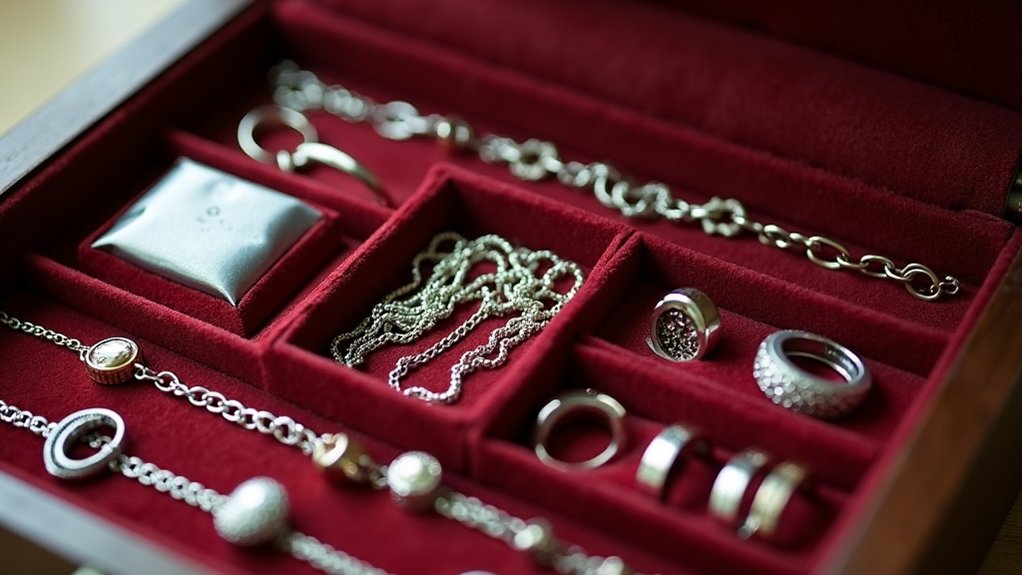
Preserving the pristine condition of custom jewelry requires strategic defense against tarnish and oxidation – two persistent threats that can diminish both appearance and value.
For effective tarnish prevention, store your pieces in anti-tarnish bags with protective strips, and utilize airtight containers lined with velvet or microfiber. Common metals like silver and copper are especially vulnerable to tarnish formation. Using separate compartments prevents scratches and tangles between pieces. You’ll need to manage humidity levels by incorporating silica gel or activated charcoal packets in your storage solution. For oxidation reduction, keep your jewelry away from chemical exposure, including perfumes, chlorine, and household cleaners. Storing pieces in cool, dry spaces helps prevent moisture from accelerating chemical reactions that cause tarnish.
Consider applying protective barriers like rhodium plating or e-coatings to seal metal surfaces. You’ll maximize protection by wiping pieces after each wear and scheduling professional maintenance annually. Don’t forget to store items separately to prevent mechanical abrasion that can accelerate tarnishing and oxidation processes.
Master Proper Cleaning Techniques
Maintaining your custom jewelry’s brilliance demands mastery of proper cleaning techniques tailored to each piece’s unique composition. Select appropriate cleaning solutions based on your jewelry’s metals and gemstones, as improper chemicals can cause irreversible damage. Placing a soft towel underneath while cleaning helps prevent accidental damage from drops or impacts. A regular cleaning routine helps preserve the sparkle and shine of your cherished pieces. For effective jewelry maintenance, consider these essential protocols:
Protect your precious jewelry’s beauty by choosing cleaning methods that respect each unique piece’s metals and gemstones.
- Use mild dish soap with warm water for routine cleaning, avoiding harsh chemicals that compromise metal integrity
- Apply gentle pressure with a soft-bristled brush to remove debris from intricate settings
- Implement ultrasonic cleaning only for compatible pieces, following manufacturer specifications
- Confirm thorough rinsing and complete drying before storage to prevent corrosion
- Consider professional cleaning services for persistent buildup or delicate pieces requiring specialized care
Never compromise your jewelry’s longevity with improper cleaning methods. Instead, adapt your approach based on each piece’s specific material composition and structural characteristics. Weekly cleaning helps identify potential issues like loose stones or prongs before they become serious problems.
Select Quality Storage Containers
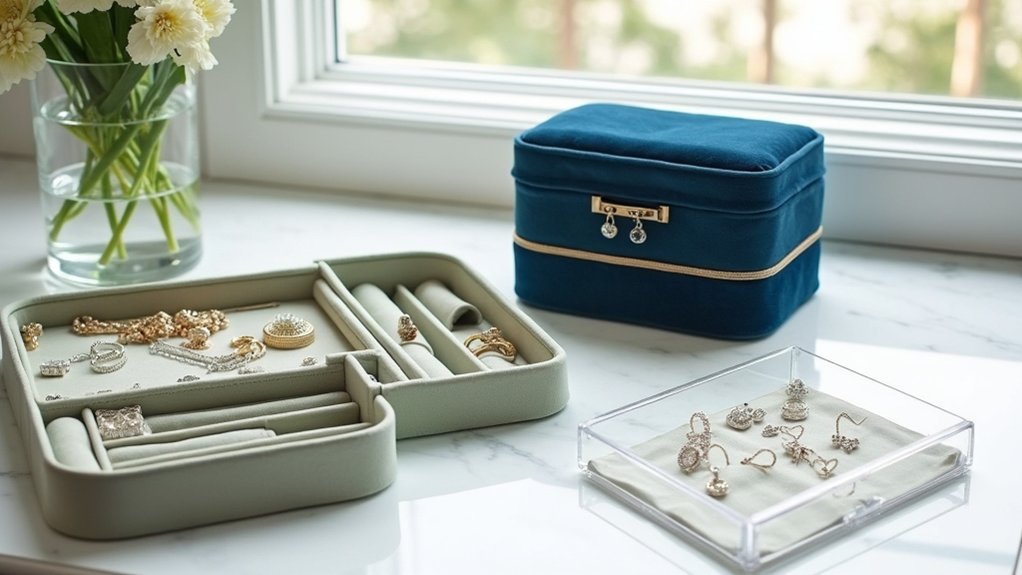
Selecting appropriate storage containers stands as a critical foundation for protecting your custom jewelry investment. Choose custom box materials that combine durability with protective features; rigid cardboard, hardwood, or kraft paperboard provide excellent structural integrity while preventing environmental damage. Modern eco-conscious options include 100% recycled content materials that maintain superior protection standards. High-quality packaging ensures your valuable pieces remain secure during long-term storage and transportation. Adding cotton batting between compartments provides essential cushioning for delicate pieces.
You’ll want containers featuring tight-fitting lids and acid-free, tarnish-resistant linings. Multi-compartment designs with adjustable dividers accommodate various piece sizes, while custom-cut foam inserts secure uniquely shaped items. For aesthetic design options, consider FSC-certified hardwoods like oak or cherry, which offer both elegance and sustainability. Enhance protection by selecting boxes with velvet or treated cloth interiors, and don’t forget to add desiccant packets for moisture control. Finished edges and mitered corners guarantee both functionality and refined presentation of your valuable pieces.
Prevent Tangling and Scratching
Keep your jewelry pieces pristine by storing each item in separate compartments, which prevents metal-on-metal contact and chain entanglement. You’ll find soft, anti-tarnish pouches essential for protecting precious metals and gemstones from microscratches and oxidation. Maintain proper spacing between pieces by using dividers or individual slots in your storage solutions, ensuring that heavier items won’t compress or damage more fragile pieces during storage or transport. For secure daily jewelry organization, implement drawer inserts with velvet to create a customized storage system that keeps items protected and easily accessible.
Individual Compartments Matter Most
Proper compartmentalization stands as the cornerstone of jewelry preservation, especially when it comes to preventing damage from tangling and scratching. Your jewelry preservation techniques should prioritize individual storage spaces that match each piece’s dimensions and characteristics.
- Custom compartment design benefits include anti-tarnish protection through specialized velvet-lined dividers
- Dedicated hooks prevent fine chains from developing frustrating knots or weakened links
- Modular sections with adjustable dividers accommodate your collection’s growth while maintaining protection
- Secure closures minimize movement-induced abrasions between metal surfaces and gemstones
- Transparent or labeled slots streamline access while keeping matching sets together
When selecting storage solutions, you’ll find that well-designed compartments not only protect your investments but also extend their lifespan. This systematic approach guarantees your pieces remain pristine and ready to wear without time-consuming maintenance.
Soft Pouches Prevent Damage
Soft pouches stand out as an essential safeguard against common jewelry damage, offering multi-layered protection through specialized materials and design features. You’ll find that quality pouch design incorporates dense textile weaves and soft linings like velvet or suede, which create protective barriers against scratches and impacts.
The soft pouch benefits extend beyond basic protection. You’re getting effective tangling prevention through individual compartments that keep pieces separated, while smooth interior fabrics reduce friction between metal surfaces. The flexible construction adapts to delicate prongs and settings, preventing pressure-induced damage to antique or complex pieces. Water-resistant materials and secure closures shield your jewelry from environmental factors like moisture and dust, while maintaining accessibility for regular wear. This all-encompassing protection makes soft pouches invaluable for both storage and transport.
Proper Spacing Between Pieces
Building upon the protective qualities of soft pouches, strategic spacing between jewelry pieces serves as your next line of defense against common storage damage. Proper spacing techniques require careful consideration of compartment sizes and individual piece dimensions to prevent metal-to-metal contact and potential scratching.
- Maintain minimum 1/4-inch clearance between pieces in adjacent compartments to prevent friction
- Select modular dividers that accommodate your largest statement pieces without compression
- Position chains and necklaces in single-layer configurations to eliminate tangling
- Utilize felt-lined compartments sized 25% larger than each piece for ideal buffer space
- Install adjustable partitions to create custom spacing for varying jewelry dimensions
When implementing these spacing protocols, you’ll greatly reduce the risk of abrasion, warping, and mechanical stress on your custom jewelry collection.
Care for Delicate Materials
When storing pearls, you’ll need to maintain controlled humidity using silica gel packets to prevent dehydration and surface cracking. To protect vintage and antique pieces, wrap them individually in acid-free tissue or soft pouches, keeping metal components from direct contact with potentially sulfurous materials. Shield gemstones and adhesive settings from UV exposure by selecting storage locations away from windows and using opaque, fabric-lined containers that block harmful light.
Protect Pearls From Drying
As natural organic gems, pearls require specific humidity conditions to maintain their lustrous beauty and structural integrity. Proper pearl hydration depends on controlled storage environments that prevent excessive drying while allowing adequate airflow. To maintain ideal humidity balance, avoid airtight containers and opt for fabric-lined boxes or natural-material pouches.
- Store pearls in soft, breathable containers that regulate moisture levels
- Wear your pearls regularly to benefit from natural skin oils and ambient humidity
- Keep pearls away from direct heat sources and sunlight to prevent dehydration
- Air your stored pearls periodically to prevent stagnant conditions
- Wipe pearls gently after wear, allowing them to dry flat before storage
Monitor your pearl jewelry for signs of drying, such as surface cracks or yellowing. Professional maintenance, including cleaning and restringing, helps preserve their natural luster and structural stability.
Wrap Vintage Pieces Carefully
Proper wrapping techniques for vintage jewelry require meticulous attention to material selection and handling protocols. When implementing preservation methods, you’ll need to select acid-free tissue paper for your initial wrap, followed by soft, lint-free cloth barriers. These vintage wrapping techniques guarantee protection against chemical reactions and surface abrasion.
You’ll want to handle each piece by its sturdiest components while wrapping, avoiding direct contact with delicate settings or loose stones. Don’t use plastic bags, as they’ll trap moisture and accelerate tarnishing. Instead, incorporate anti-tarnish strips within your storage solution. For maximum protection, place each wrapped piece in individual compartments, using padded dividers to prevent contact between items. Remember to inspect your vintage pieces regularly for signs of setting weakness or stone movement, adjusting your wrapping technique if you notice any concerning changes.
Shield Gems From Light
Protecting gemstones from harmful light exposure requires strategic storage solutions to prevent color fading and structural degradation. UV rays pose a significant threat to gem brilliance, particularly affecting emeralds, rubies, sapphires, and opals. You’ll need UV-protective storage to minimize light damage and maintain your jewelry’s value.
- Store pieces in fabric-lined boxes with dividers to prevent stone-to-stone contact
- Choose opaque containers over transparent ones to block UV penetration
- Maintain room temperature (70°F) and moderate humidity (40-50%)
- Use silica gel packets to regulate moisture levels
- Install UV-protective glass for displayed pieces
For ideal protection, place your storage containers away from windows, heating vents, and direct sunlight. Consider applying protective coatings on highly sensitive stones, and regularly inspect settings for signs of UV-related deterioration.
Maintain Safe Temperature and Humidity
Maintaining precise temperature and humidity levels plays an essential role in preserving your custom jewelry’s integrity. Store your pieces in an environment between 18-24°C (65-75°F), with relative humidity of 40-50% for general collections or 35-45% for precious items in humid climates.
To guarantee temperature stability and humidity control, install digital sensors and hygrometers to monitor conditions continuously. You’ll need to position your storage away from bathrooms, kitchens, and heat sources that can cause damaging fluctuations. Deploy dehumidifiers with automatic controls in moisture-prone areas, and use silica gel packets inside jewelry containers for localized protection.
For material-specific care, store opals, pearls, and other organic gems with extra attention to humidity levels, as they’re particularly vulnerable to both excessive moisture and dryness.
Implement Security Measures
You’ll need a thorough smart security system that integrates AI-driven surveillance cameras with electronic access controls to protect your custom jewelry collection. Install commercial-grade display cases with reinforced glass and multi-factor authentication locks to prevent unauthorized access and smash-and-grab attempts. Secure your pieces in high-quality locking boxes equipped with tamper-evident seals and maintain detailed access logs to track handling of valuable items.
Install Smart Security Systems
Smart security systems serve as the cornerstone of professional jewelry storage protection, combining high-definition surveillance, biometric access controls, and sophisticated intrusion detection. Install surveillance cameras strategically to cover all critical areas while implementing multi-layered access control measures for maximum security.
Key components of your smart security setup should include:
- Cloud-integrated HD cameras with remote monitoring capabilities
- Biometric authentication systems for restricted area access
- Motion-activated sensors linked to central monitoring
- Dual-communication alarm systems with cellular backup
- RFID-enabled tracking and logging of all entry points
Ensure professional installation of these integrated systems, focusing on seamless communication between components. You’ll want cloud-based management capabilities for remote access and real-time alerts. Regular maintenance and testing will verify your system’s reliability, while employee training enhances overall security effectiveness.
Choose Quality Locking Boxes
Beyond digital security systems, physical storage solutions represent the last line of defense for protecting custom jewelry collections. Select UL-rated safes with proven lock durability, featuring multiple steel layers and concrete cores for enhanced fire and theft protection. You’ll want models offering versatile key access options, including mechanical, digital, or biometric locks that support multi-user configurations.
Consider safes with RSC or B/C ratings appropriate for your collection’s value, ensuring they meet insurance requirements. Look for designs with solid steel bolts, concealed hinges, and pre-drilled mounting points for permanent installation. Interior customization options like microsuede lining and specialized drawer configurations prevent scratching while organizing pieces efficiently. Choose finishes that integrate with your décor while maintaining structural integrity, and opt for motion-activated LED lighting to facilitate safe retrieval.
Handle With Proper Care and Rotation
When preserving custom jewelry’s longevity, proper handling techniques and systematic rotation form the cornerstone of effective care. Implementing a strategic rotation schedule delivers multiple benefits, from minimizing structural fatigue to maintaining ideal material integrity. Your inspection routine should align with your rotation system to monitor each piece’s condition effectively.
Key practices for handling and rotation include:
- Handle pieces with clean, dry hands and lift by sturdy components to prevent stress on delicate elements
- Store in compartmentalized holders away from direct sunlight and fluctuating temperatures
- Rotate frequently worn items systematically to distribute wear and prevent setting fatigue
- Position jewelry in accessible locations that encourage natural rotation patterns
- Document inspection findings during rotation cycles to track maintenance needs
Your rotation system should incorporate dedicated storage solutions while maintaining ease of access for regular wear and assessment.
Frequently Asked Questions
How Often Should I Have My Custom Jewelry Professionally Appraised?
You’ll want to have your custom jewelry professionally appraised every 2-5 years to maintain accurate valuations. However, you should seek immediate appraisals when significant market fluctuations occur or after repairs and modifications. Your appraisal frequency may need adjustment based on your insurance requirements, the jewelry value, and material composition. For high-value pieces containing gold or precious gems, consider more frequent assessments to guarantee your coverage matches current replacement costs.
Can I Store Different Types of Metals Together in the Same Compartment?
No, you shouldn’t store different metals together in the same compartment due to metal compatibility issues. When metals come into contact, they can trigger galvanic reactions that accelerate tarnishing, especially in silver pieces. For the best tarnish prevention, store each metal type separately in felt-lined pouches or compartments. Use anti-tarnish strips and silica gel packets to absorb moisture, and keep your pieces in airtight containers away from humidity and temperature fluctuations.
What Insurance Options Are Best for Protecting Custom Jewelry Collections?
For your custom jewelry insurance needs, you’ll get the best protection through a dedicated jewelry policy that combines scheduled coverage for high-value pieces and blanket coverage for your broader collection. Unlike standard homeowner’s riders, specialized jewelry collection coverage offers worldwide protection, zero deductibles, and automatic value adjustments up to 150%. You’ll also benefit from preventative maintenance coverage and access to GIA-certified experts for appraisals and claims support.
Should I Photograph My Custom Pieces for Documentation and Insurance Purposes?
Yes, you should absolutely photograph your custom jewelry for insurance documentation. Use proper photographing techniques, including macro lenses and focus stacking, to capture every detail. You’ll need clear shots from multiple angles showing unique markings, gemstones, and settings. Store these high-resolution images in secure cloud storage and provide them to your insurer. Documentation importance can’t be overstated; it’s vital for proving ownership, establishing value, and expediting claims.
How Do I Safely Transport Custom Jewelry When Traveling Internationally?
When traveling internationally, secure your custom jewelry in acid-free tissue and anti-tarnish pouches, then place them in a hard-shell travel case with separate compartments. You’ll want to keep valuable pieces in your carry-on luggage – never check them. Document your pieces with photos and appraisals before departure, and check your destination country’s customs regulations. Consider temporary travel insurance that specifically covers jewelry during international transport.

